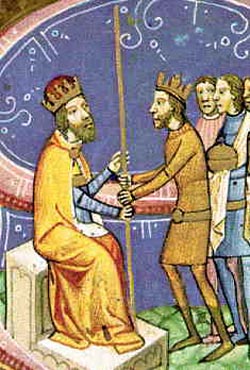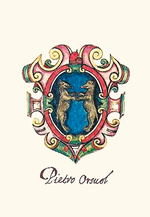
Feastday: January 10
Birth: 928
Death: 987
Peter Orseolo, of Rivo Alto, Italy, served as commander of the Venetian navy before becoming doge of Venice in 976. In this office he rebuilt the fire-ravaged Saint Mark’s Cathedral, funding the work from his own wealth. From Constantinople he obtained for the cathedral’s high altar what is considered the earliest known example of a gold altar cloth. He also founded a hospice for pilgrims. But after governing for only two years, Peter suddenly disappeared from the city during the night of September 1-2, 978. He fled his prestigious station to devote the rest of his life to God, traveling over five hundred miles westward to enter the Benedictine monastery of Cuxa, at the foot of the eastern Pyrenees, along the French-Spanish border. As he neared the monastery, Peter took off his shoes and walked the remaining steps of the journey bare-footed. As a monk, he excelled in humility, devotion to prayer, charity, and self-denial. Thereafter, Peter’s zeal for even greater perfection prompted him to obtain permission to live in solitude a short distance from the monastery.
Pietro I Orseolo, O.S.B. Cam. (Peter Urseulus) (928–987) was the Doge of Venice from 976 until 978. He abdicated his office and left in the middle of the night to become a monk. He later entered the Camaldolese Order. He is venerated as a saint in the Catholic Church following his canonization in 1731. In 1733 the Venetian librarian Giuseppe Bettinelli published an edition of a biography written by the heretical Friar Fulgenzio Manfredi in 1606.
Early life
Orseolo was born in 928 near Udine to one of the more powerful families in Venice: the Orseolo who were the descendants of Teodato Ipato and Orso Ipato. At the age of 20 he was named commander of the Venetian fleet, performing distinguished service as a soldier; he waged successful campaigns against the Dalmatian pirates. He was also devoted to the Catholic Church.
Reign
 Coat of arms.
Coat of arms.
In 976, the sitting doge, Pietro IV Candiano, was killed in a revolution that protested his attempts to create a monarchy. According to a statement by the Camaldolese monk and cardinal, Peter Damian, Orseolo himself had led a conspiracy against Candiano. This statement, however, cannot be verified. Nonetheless, Orseolo was elected as his successor. His wife and consort was Felicia Malipiero.
As doge, Orseolo demonstrated a good deal of talent in restoring order to an unsettled Venice and showed remarkable generosity in the treatment of his predecessor's widow. He built hospitals and cared for widows, orphans and pilgrims. Out of his own resources he began the reconstruction of the ducal chapel, now St. Mark's Basilica, and the doge's palace, which had been destroyed during the revolution, along with a great part of the city. Two years later, on 1 September 978, seemingly without notifying anyone, not even his wife and children, he left Venice with Abbot Guarin and three other Venetians (one of whom was St. Romuald) to join the Benedictine (now Cistercian) abbey at Saint-Michel-de-Cuxa (Catalan: Sant Miquel de Cuixà) in Prades (Catalan: Prada), southern France.
Here Orseolo led a life of great asceticism, performing the most menial tasks. There is some evidence that he had been considering such an action for some time. His only contact with Venice was to instruct his grandson Otto (who would become doge in 1008) in the life of Christian virtue. After some years as a monk at the abbey, probably with the encouragement of Saint Romuald (who later went on to found the Camaldolese branch of the Benedictines), Orseolo left the monastery to become a hermit in the surrounding forest, a calling he followed for seven years until he died. His body is buried in the village church in Prades (Catalan: Prada), France.
Veneration
Forty years after his death, in 1027, Orseolo was officially recognized as a blessed by the local bishop.
Orseolo is venerated as a saint by the Catholic Church, his cultus having been confirmed by his equivalent canonization in 1731 by Pope Clement XII, who set his feast day for January 14. The reform of the liturgical calendar in 1969 transferred the feast to January 10, the day of his death. The Camaldolese, however, celebrate his memory on January 19.





